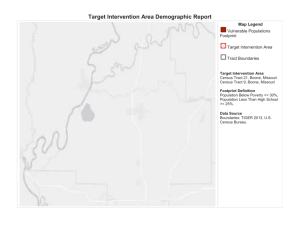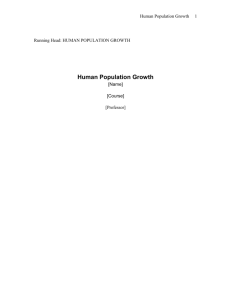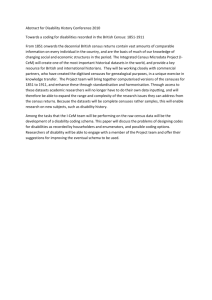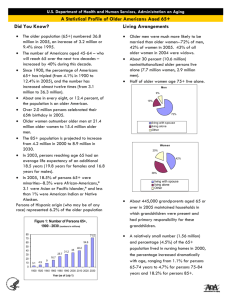A Profile of Older Americans: 2001
advertisement
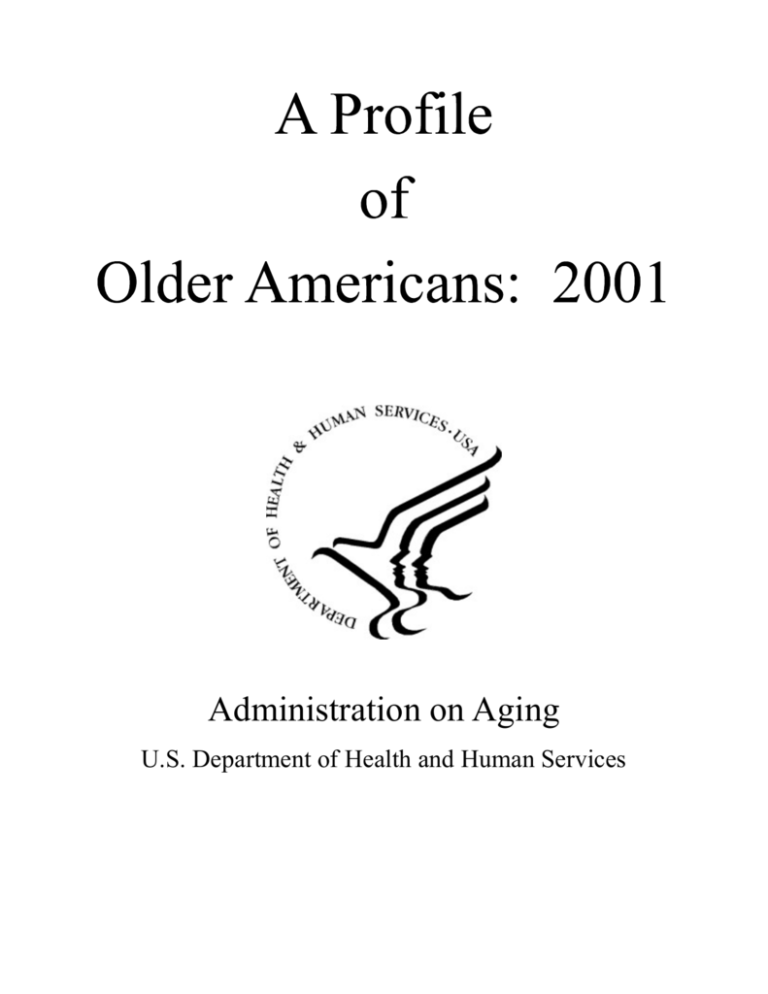
Administration on Aging U.S. Department of Health and Human Services Table of Contents Highlights The Older Population…………………………………………………………………………. Figure 1: Number of Persons 65+, 1900 - 2030 (numbers in millions) 1 Future Growth………………………………………………………………………………… 2 Marital Status…………………………………………………………………………………. Figure 2: Marital Status of Persons 65+ - 2000 3 Living Arrangements…………………………………………………………………………. Figure 3: Living Arrangements of Persons 65+: 2000* 4 Racial and Ethnic Composition……………………………………………………………….. 5 Geographic Distribution………………………………………………………………………. Figure 4: Persons 65+ as Percentage of Total Population by State: 2000 (US Map) Figure 5: Percentage Increase in Population 65+ by State: 2000 (US Map) Figure 6: The 65+ Population by State: 2000 (table) 5 Income ……………………………………………………………………………………….. Figure 7: Percent Distribution by Income: 2000 9 Poverty ..…………………………...………………………………………………………… 10 Housing ……………………………………………………………………………………… 10 Employment …………………………………………………………………………………. 11 Education ……………………………………………………………………………………. 11 Health, Health Care, and Disability ……………………………………………………………11 Figure 8: Percent With Disabilities, By Age: 1997 Special Topic: Computer and Internet Access……………………………………………. 13 Footnotes ……………………………………………………………………………………. 13 Highlights · The older population (65+) numbered 35.0 million in 2000, an increase of 3.7 million or · The number of Americans aged 45-64 – who will reach 65 over the next two decades – increased by 34% during this decade. About one in every eight, or 12.4 percent, of the population is an older American. Over 2.0 million persons celebrated their 65th birthday in 2000 (5,574 per day). Older women outnumber older men at 20.6 million older women to 14.4 million older men. About 30 percent (9.7 million) noninstitutionalized older persons live alone (7.4 million women, 2.4 million men). Half of older women age 75+ live alone. By the year 2030, the older population will more than double to about 70 million. The 85+ population is projected to increase from 4.2 million in 2000 to 8.9 million in 2030. Members of minority groups are projected to represent 25 percent of the older population in 2030, up from 16 percent in 2000. The median income of older persons in 2000 was $19,168 for males and $10,899 for females. Real median income (after adjusting for inflation) fell by -2.8% for men and by -3.6% for women since 1999. The Social Security Administration reported that the major sources of income for older people was: o Social Security (reported by 90 percent of older persons), o Income from assets (reported by 62 percent), o Public and private pensions (reported by 43 percent), and o Earnings (reported by 22 percent). About 3.4 million older persons lived below the poverty level in 2000. The poverty rate for persons 65+ continued at a historically low rate of 10.2 percent. Another 2.2 million older adults were classified as "near poor" (income between poverty level and 125 percent of this level). · · · · · · · · · · · 12.0% since 1990. The Older Population* The older population--persons 65 years or older--numbered 35.0 million in 2000. They represented 12.4% of the U.S. population, about one in every eight Americans. The number of older Americans increased by 3.7 million or 12.0% since 1990, compared to an increase of 13.3% for the under-65 population. However, the number of Americans aged 45-64 – who will reach 65 over the next two decades – increased by 34% during this period. In 2000, there were 20.6 million older women and 14.4 million older men, or a sex ratio of 143 women for every 100 men. The female to male sex ratio increases with age, ranging from 117 for the 65-69 age group to a high of 245 for persons 85 and over. Since 1900, the percentage of Americans 65+ has more than tripled (4.1% in 1900 to 12.4% in 2000), and the number has increased eleven times (from 3.1 million to 35.0 million). The older population itself is getting older. In 2000, the 65-74 age group (18.4 million) was eight times larger than in 1900, but the 7584 group (12.4 million) was 16 times larger and the 85+ group (4.2 million) was 34 times larger. In 2000, persons reaching age 65 had an average life expectancy of an additional 17.9 years (19.2 years for females and 16.3 years for males). A child born in 2000 could expect to live 76.9 years, about 29 years longer than a child born in 1900. Much of this increase occurred because of reduced death rates for children and young adult. However, the past two decades have also seen reduced death rates for the population aged 65-84, especially for men – by 19% for men aged 65-74 and by 16% for men aged 75-84. Life expectancy at age 65 increased by only 2.4 years between 1900 and 1960, but has increased by 3.7 years since 1960. Over 2.0 million persons celebrated their 65th birthday in 2000 (5,574 per day). In the same year, about 1.8 million persons 65 or older died, resulting in a net increase of approximately 238,000 (650 per day). There were 50,545 persons aged 100 or more in 2000 (0.02% of the total population). This is a 35% increase from the 1990 figure of 37,306. (Data for this section were compiled primarily from Internet releases of the U.S. Bureau of the Census and the National Center for Health Statistics). Future Growth The older population will continue to grow significantly in the future (see Figure 1). This growth slowed somewhat during the 1990's because of the relatively small number of babies born during the Great Depression of the 1930's. But the older population will burgeon between the years 2010 and 2030 when the "baby boom" generation reaches age 65. By 2030, there will be about 70 million older persons, more than twice their number in 2000. People 65+ represented 12.4% of the population in the year 2000 but are expected to grow to be 20% of the population by 2030. Minority populations are projected to represent 25.4% of the elderly population in 2030, up from 16.4% in 2000. Between 1999 and 2030, the white** population 65+ is projected to increase by 81% compared with 219% for older minorities, including Hispanics (328%), African-Americans** (131%), American Indians, Eskimos, and Aleuts** (147%), and Asians and Pacific Islanders** (285%). (Sources: “Projections of the Total Resident Population by 5 Year Age Groups, Race, and Hispanic Origin with Special Age Categories: Middle Series, 1999 to 2000,” U.S. Census Internet Release Date: January 13,2000 with "Population Projections of the United States by Age, Sex, Race and Hispanic Origin: 1995-2050," Current Population Reports, P25-1130. Data for 2000 are from the 2000 Census.) Figure 1: Number of Persons 65+, 1900 - 2030 (numbers in millions) 80 70 60 50 40 30 20 10 0 70.3 53.7 25.7 3.1 4.9 9 31.2 35 39.7 16.7 1900 1920 1940 1960 1980 1990 2000 2010 2020 2030 Year (as of July 1) Note: Increments in years are uneven. Based on data from the U.S. Bureau of the Census - 2- Marital Status In 2000, older men were much more likely to be married as older women--74% of men, 43% of women (Figure 2). Almost half of all older women in 2000 were widows (45%). There were over four times as many widows (8.5 million) as widowers (2.0 million). Divorced and separated older persons represented only 8% of all older persons in 2000. However, their numbers (2.6 million) have increased significantly since 1990, when approximately 1.5 million of the older population were divorced or separated. Figure 2: Marital Status of Persons 65+ - 2000 80% 74% 70% Women 60% 50% 43% Men 45% 40% 30% 14% 20% 10% 4% 4% 8% 7% Single (never married) Divorced or Separated 0% Married Widowed (Based on data from the U.S. Bureau of the Census. See: "America’s Families and Living Arrangements; Population Characteristics: June, 2001, Current Population Reports, P20-537”) -3- Living Arrangements Over half (55%) the older noninstitutionalized persons lived with their spouse in 2000. Approximately 10.1 million or 73% of older men, and 7.7 million or 41% of older women, lived with their spouse (Figure 3). The proportion living with their spouse decreased with age, especially for women. Only 28.8% of women 75+ years old lived with a spouse. About 30% (9.7 million) of all noninstitutionalized older persons in 2000 lived alone (7.4 million women, 2.4 million men). They represented 40% of older women and 17% of older men. The proportion living alone increases with advanced age. Among women aged 75 and over, for example, half (49.4%) lived alone. About 633,000 grandparents aged 65 or over maintained households in which grandchildren were present in 1997. In addition, 510,000 grandparents over 65 years lived in parent- maintained households in which their grandchildren were present. While a relatively small number (1.56 million) and percentage (4.5%) of the 65+ population lived in nursing homes in 2000, the percentage increases dramatically with age, ranging from 1.1% for persons 65-74 years to 4.7% for persons 75-84 years and 18.2% for persons 85+. Figure 3: Living Arrangements of Persons 65+: 2000* Men Wom en 10% 19% 17% 41% 40% 73% living with spouse living alone Other living with spouse living alone Other (Based on data from U.S. Bureau of the Census. See: "America’s Families and Living Arrangements; Population Characteristics: June, 2001, Current Population Reports, P20-537” and “The 65 Years and Over Population: 2000, Census 2000 Brief, October, 2001.”) -4- Racial and Ethnic Composition In 2000, 16.4% of persons 65+ were minorities--8.0% were African-Americans,** 2.4% were Asian or Pacific Islander,** and less than 1% were American Indian or Native Alaskan.** Persons of Hispanic origin (who may be of any race) represented 5.6% of the older population. In addition, 0.8% of persons 65+ identified themselves as being of two or more races. Only 6.6% of minority race and Hispanic populations were 65+ in 2000 (8.2% of African-Americans,** 7.8% of Asians and Pacific Islanders,** 6.0% of American Indians and Native Alaskans,** 4.9% of Hispanics), compared with 15.0% of whites.** (Data for this section were compiled from Internet releases of the Census 2000 data). Geographic Distribution In 2000, about half (52%) of persons 65+ lived in nine states. California had over 3.6 million; Florida 2.8 million; New York 2.4 million; Texas 2.1 million; and Pennsylvania 1.9 million. Ohio, Illinois, Michigan, and New Jersey each had well over 1 million (Figure 4). Person 65+ constituted 14.0% or more of the total population in 9 states in 2000 (Figure 4): Florida (17.6%); Pennsylvania (15.6%); West Virginia (15.3%); Iowa (14.9%); North Dakota (14.7%); Rhode Island (14.5%); Maine (14.4); South Dakota (14.3); and Arkansas (14.0%). In fourteen states, the 65+ population increased by 20% or more between 1990 and 2000 (Figure 5): Nevada (71.5%); Alaska (59.6%); Arizona (39.5%); New Mexico (30.1%); Hawaii (28.5%); Utah (26.9%); Colorado (26.3%); Delaware (26.0%); South Carolina (22.3%); Wyoming (22.2%); Texas (20.7%); North Carolina (20.5%); Idaho (20.3%); and Georgia (20.0%). The eleven jurisdictions with the highest poverty rates for elderly over the period 1998-2000 were Mississippi (17.7%); Louisiana (16.8%); District of Columbia (16.7%); Alabama (15.3%); Tennessee (15.2%); Arkansas (15.2%); New Mexico (14.5%); Kentucky (13.3%); West Virginia (13.2%); New York (13.1%); and Texas (13.0%). Most persons 65+ lived in metropolitan areas in 2000 (77.5%). About 50% of older persons lived in the suburbs, 27% lived in central cities, and 23% lived in nonmetropolitan areas. The elderly are less likely to change residence than other age groups. In 1999 only 4.2% of elderly households had moved since 1998 (compared to 16.5% of persons under 65). Among the movers, home ownership declined from 60% to 48%. (Data for this section and for Figure 4 were compiled primarily from Internet releases of the U.S. Bureau of the Census). -5- Figure 4: Persons 65+ as a Percentage of Total Population - 2000 Percent 65+ by State Based on 2000 Census 13.8 to 13.1 to 12.3 to 11.6 to 5.6 to Based on Census 2000 Data from the U.S. Bureau of the Census -6- 17.6 13.8 13.1 12.3 11.6 (10) (9) (10) (10) (12) Figure 5: Percentage Increase in Population 65+ -- 1990 to 2000 % Increase in Population 65+: 1990-2000 Based on Census Data 970,000 to 3,600,000 (9) 600,000 to 970,000 (10) 420,000 to 600,000 (10) 160,000 to 420,000 (11) 30,000 to 160,000 (11) Based on Census 2000 and 1990 Census Data. -7- Figure 6: The 65+ Population by State 2000 Numbers US Total Alabama Alaska Arizona Arkansas California Colorado Connecticut Delaware District of Columbia Florida Georgia Hawaii Idaho Illinois Indiana Iowa Kansas Kentucky Louisiana Maine Maryland Massachusetts Michigan Minnesota Mississippi Missouri Montana Nebraska Nevada New Hampshire New Jersey New Mexico New York North Carolina North Dakota Ohio Oklahoma Oregon Pennsylvania Rhode Island South Carolina South Dakota Tennessee Texas Utah Vermont Virginia Washington West Virginia Wisconsin Wyoming Number of Persons 34,991,753 579,798 35,699 667,839 374,019 3,595,658 416,073 470,183 101,726 69,898 2,807,597 785,275 160,601 145,916 1,500,025 752,831 436,213 356,229 504,793 516,929 183,402 599,307 860,162 1,219,018 594,266 343,523 755,379 120,949 232,195 218,929 147,970 1,113,136 212,225 2,448,352 969,048 94,478 1,507,757 455,950 438,177 1,919,165 152,402 485,333 108,131 703,311 2,072,532 190,222 77,510 792,333 662,148 276,895 702,553 57,693 Percent Below Percent of All Percent Increase Poverty 1998Ages 1990-2000 2000 *** 12.4 12.0% 10.1% 13.0 10.9% 15.3% 5.7 59.6% 6.0% 13.0 39.5% 8.8% 14.0 6.8% 15.2% 10.6 14.7% 8.4% 9.7 26.3% 5.0% 13.8 5.4% 6.9% 13.0 26.0% 6.8% 12.2 -10.2% 16.7% 17.6 18.5% 8.4% 9.6 20.0% 10.3% 13.3 28.5% 7.3% 11.3 20.3% 7.5% 12.1 4.4% 10.0% 12.4 8.1% 9.3% 14.9 2.4% 6.7% 13.3 4.0% 7.9% 12.5 8.1% 13.3% 11.6 10.2% 16.8% 14.4 12.3% 10.3% 11.3 15.8% 12.1% 13.5 5.0% 9.0% 12.3 10.0% 8.5% 12.1 8.7% 10.7% 12.1 6.9% 17.7% 13.5 5.3% 8.7% 13.4 13.6% 7.6% 13.6 4.1% 10.1% 11.0 71.5% 8.5% 12.0 18.3% 8.2% 13.2 7.9% 7.3% 11.7 30.1% 14.5% 12.9 3.6% 13.1% 12.0 20.5% 12.7% 14.7 3.8% 11.5% 13.3 7.2% 7.6% 13.2 7.5% 10.7% 12.8 12.0% 8.3% 15.6 4.9% 7.8% 14.5 1.2% 10.4% 12.1 22.3% 12.6% 14.3 5.7% 9.8% 12.4 13.7% 15.2% 9.9 20.7% 13.0% 8.5 26.9% 7.3% 12.7 17.2% 9.0% 11.2 19.2% 11.5% 11.2 15.1% 6.9% 15.3 3.0% 13.2% 13.1 7.9% 8.3% 11.7 22.2% 9.8% (Compiled by the Administration on Aging from Table DP-1. Profile of General Demographic Characteristics for the United States: 2000; poverty data is from the Current Population Surveys) -8- Income The median income of older persons in 2000 was $19,168 for males and $10,899 for females. Real median income (after adjusting for inflation) fell by -2.8% for men and by -3.6% for women since 1999. Households containing families headed by persons 65+ reported a median income in 2000 of $32,854 ($33,467 for Whites, $27,952 for African-Americans, and $24,330 for Hispanics). About one of every eight (12.1%) family households with an elderly householder had incomes less than $15,000 and 46.8% had incomes of $35,000 or more (Figure 7). Figure 7: Percent Distribution by Income: 2000* Family Households 65+ Householder 0.0% Under $10,000 5.0% 10.0% 15.0% 20.0% 25.0% 4.0% 8.1% $10,000 - $14,999 21.7% $15,000 - $24,999 19.4% $25,000 - $34,999 18.4% $35,000 - $49,999 $50,000 - $74,999 14.5% $75,000 and over 13.9% $32,854 median for 11.6 million family households 65+ Persons 65+ Reporting Income 0% 10% 20% 7.7% Under $5,000 30% 26.2% $5,000 - $9,999 20.8% 21.4% $10,000 - $14,999 $15,000 - $24,999 9.8% $25,000 - $34,999 $35,000 - $49,999 $50,000 and over 6.5% 7.7% $13,769 median for 32.3 million persons 65+ reporting income -9- For all older persons reporting income in 2000 (33.9 million), 33.9% reported less than $10,000. Only 23.9% reported $25,000 or more. The median income reported was $13,769. The major sources of income as reported by the Social Security Administration for older persons in 1999 were Social Security (reported by 90% of older persons), income from assets (reported by 62%), public and private pensions (reported by 43%), and earnings (reported by 22%). In 2000, Social Security benefits accounted for 38% of the aggregate income of the older population. The bulk of the remainder consisted of earnings (21%), assets (20%), and pensions (19%). (Based on data from Current Population Reports, "Consumer Income," P60-213, issued September, 2001, by the U.S. Bureau of the Census, related Census Internet releases, and from the 2000 Supplement to the Social Security Bulletin) Poverty About 3.4 million elderly persons (10.2%) were below the poverty level in 2000. This poverty rate was not statistically different from the historic low reached in 1999. Another 2.2 million or 6.7% of the elderly were classified as "near-poor" (income between the poverty level and 125% of this level). One of every twelve (8.9%) elderly Whites was poor in 2000, compared to 22.3% of elderly AfricanAmericans and 18.8% of elderly Hispanics. Higher than average poverty rates for older persons were found among those who lived in central cities (12.4%), outside metropolitan areas (i.e. rural areas) (13.2%), and in the South (12.7%). Older women had a higher poverty rate (12.2%) than older men (7.5%) in 2000. Older persons living alone or with nonrelatives were much more likely to be poor (20.8%) than were older persons living with families (5.1%). The highest poverty rates (38.3%) were experienced by older Hispanic women who lived alone or with nonrelatives. (Based on data from Current Population Reports, "Poverty in the United States: 2000," P60-214, Issued September, 2001 and related Internet releases of the U.S. Bureau of the Census). Housing 0f the 21.4 million households headed by older persons in 1999, 80% were owners and 20% were renters. The median family income of older homeowners was $22,502. The median family income of older renters was $12,566. In 1999, 39% of older householders spent more than one-fourth of their income on housing costs, compared to 36% of for homeowners of all ages. For homes occupied by older householders in 1999, the median year of construction was 1962 (it was 1969 for all householders) and 6% had physical problems. In 1999, the median value of homes owned by older persons was $96,442, compared to a median home value of $108,300 for all homeowners. About 76% of older homeowners in 1999 owned their homes free and clear. (Source: "American Housing Survey for the United States in 1999, Current Housing Reports" H150/99.) - 10 - Employment In 2000, 4.2 million (12.8 %) Americans age 65 and over were in the labor force (working or actively seeking work), including 2.4 million men (17.5%) and 1.8 million women (9.4%). They constituted 3.0% of the U.S. labor force. About 3.1% were unemployed. Labor force participation of men 65+ decreased steadily from 2 of 3 in 1900 to 15.8% in 1985, and has stayed at 16%-18% since then. The participation rate for women 65+ rose slightly from 1 of 12 in 1900 to 10.8% in 1956, fell to 7.3% in 1985, and has been around 8%-10% since 1988. (Source: Bureau of Labor Statistics web-site: http://www.bls.gov/cps). Education The educational level of the older population is increasing. Between 1970 and 2000, the percentage who had completed high school rose from 28% to 70% About 16% in 2000 had a bachelor's degree or more. The percentage who had completed high school varied considerably by race and ethnic origin among older persons in 2000: 74% of Whites, 63% of Asians and Pacific Islanders, 46% of African-Americans, and 37% of Hispanics. (Sources: Current Population Reports, "Educational Attainment in the United States (Update): March 2000," P20-536 and related tables on the Census Bureau web site.) Health, Health Care, and Disability In 1999, 26.1% of older persons assessed their heath as fair or poor (compared to 9.2% for all persons). There was little difference between the sexes on this measure, but older African-Americans (41.6%) and older Hispanics (35.1%) were much more likely to rate their health as fair or poor than were older Whites (26%).**** Limitations on activities because of chronic conditions increase with age. In 1998, among those 65-74 years old, 28.8 percent reported a limitation caused by a chronic condition. In contrast, over half (50.6%) of those 75 years and over reported they were limited by chronic conditions. In 1997, more than half of the older population (54.5%) reported having at least one disability of some type (physical or nonphysical). Over a third (37.7%) reported at least one severe disability. Over 4.5 million (14.2%) had difficulty in carrying out activities of daily living (ADLs) and 6.9 million (21.6%) reported difficulties with instrumental activities of daily living (IADLs). This is in sharp contrast to the much lower levels in the 25-64 populations of ADL difficulties (2.8%) and IADL difficulties (4%). [ADLs include bathing, dressing, eating, and getting around the house. IADLs include preparing meals, shopping, managing money, using the telephone, doing housework, and taking medication]. The percentages with disabilities increase sharply with age (Figure 8). Disability takes a much heavier toll on the very old. Almost three-fourths (73.6%) of those aged 80+ report at least one disability. Over half (57.6%) of those aged 80+ had one or more severe disabilities and 34.9% of the 80+ population reported - 11 - needing assistance as a result of disability. There is a strong relationship between disability status and reported health status. Among those 65+ with a severe disability, 68.0% reported their health as fair or poor. Among the 65+ persons who reported no disability, only 10.5% reported their health as fair or poor. Presence of a severe disability is also associated with lower income levels and educational attainment. Figure 8: Percent With Disabilities, By Age: 1997 Figure 8: Percent with Disabilities, by Age 80 70 60 50 40 30 20 10 0 73.6 57.7 57.6 65-69 46.6 44.9 38 34.9 30.7 28.3 16.9 8.1 10.5 % with any disability % with severe disability 70-74 75-79 80+ % need assistance Most older persons have at least one chronic condition and many have multiple conditions. The most frequently occurring conditions per 100 elderly in 1996 were: arthritis (49), hypertension (36), hearing impairments (30), heart disease (27), cataracts (17), orthopedic impairments (18), sinusitis (12), and diabetes (10). Older people had about four times the number of days of hospitalization (1.6 days) as did the under 65 aged population (0.4 days) in 1999. The average length of a hospital stay was 6.0 days for older people, compared to only 4.1 days for people under 65. The average length of stay for older people has decreased 6 days since 1964. Older persons averaged more contacts with doctors in 1999 than did persons of all ages (6.8 contacts vs. 3.5 contacts). In 1999, older consumers averaged $3,019 in out-of-pocket health care expenditures, an increase of more than a third since 1990. In contrast, the total population spent considerably less, averaging $1,959 in outof-pocket costs. Older Americans spent 11%of their total expenditures on health, more than twice the proportion spent by all consumers (5%). Health costs incurred on average by older consumers in 1999 consisted of $1554 (51%) for insurance, $706 (23%) for drugs, $601 (20%) for medical services, and $158 (5%) for medical supplies. (Sources: Health United States: 2001; Current Population Reports, "Americans with Disabilities, 1997" P70-73, February 2001 and related Internet data; Internet releases of the Census Bureau and the National Center on Health Statistics; and unpublished tables from the Bureau of Labor Statistics) - 12 - Special Topic: Computer and Internet Access Among the 21.8 million households where the householder was 65 or older, 5.3 million households (24.3%) had a computer, slightly less than half the figure for the general population (51.6%). Internet access was present in 3.9 million (17.7%) of the elderly households which is 42.6% of the figure for the general population (41.5%). On an individual basis, 9.3 million (28.4%) of the older persons had home computer access and 4.2 million (12.8%) used the Internet at home, which is 34% of the figure for the general population. Footnotes: *Principal sources of data for the Profile are the U.S. Bureau of the Census, the National Center of Health Statistics, and the Bureau of Labor Statistics. **Excludes persons of Hispanic origin. ***Calculated on the basis of the official poverty definitions for the years 1998-2000 ****1996 figure A Profile of Older Americans: 2001 was prepared by the Administration on Aging (AoA), U.S. Department of Health and Human Services. The annual Profile of Older Americans was originally developed and researched by Donald G. Fowles, AoA. Saadia Greenberg, AoA, updated the 2001 edition. Editions of the Profile prior to 2000 were printed by AARP. AoA serves as an advocate for the elderly within the federal government and is working to encourage and coordinate a responsive system of family and community based services throughout the nation. AoA helps states develop comprehensive service systems which are administer by 57 State and Territorial Units on Aging, 655 Area Agencies on Aging, over 225 Native American organizations, and more than 27,000 local service providers. - 13 -

